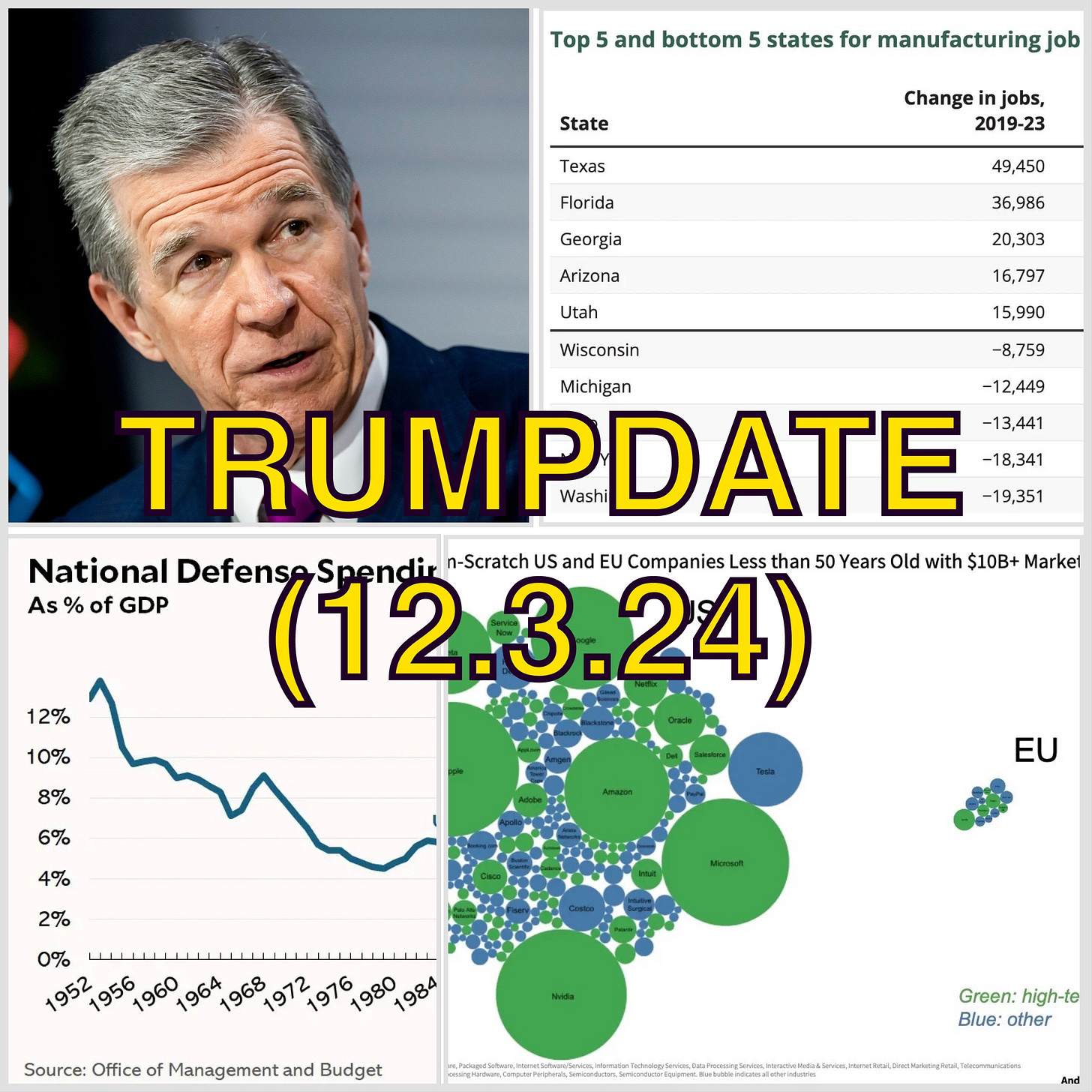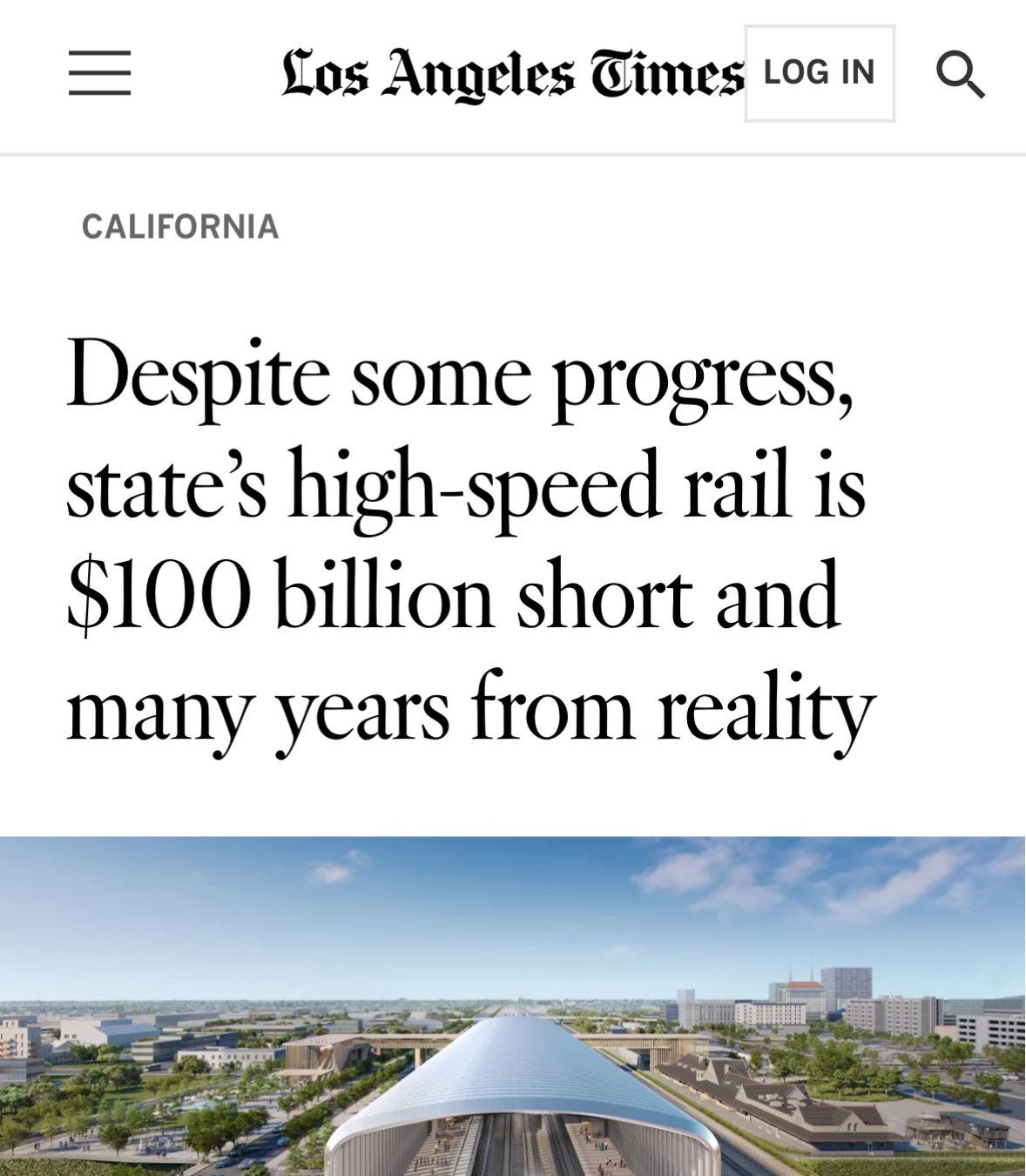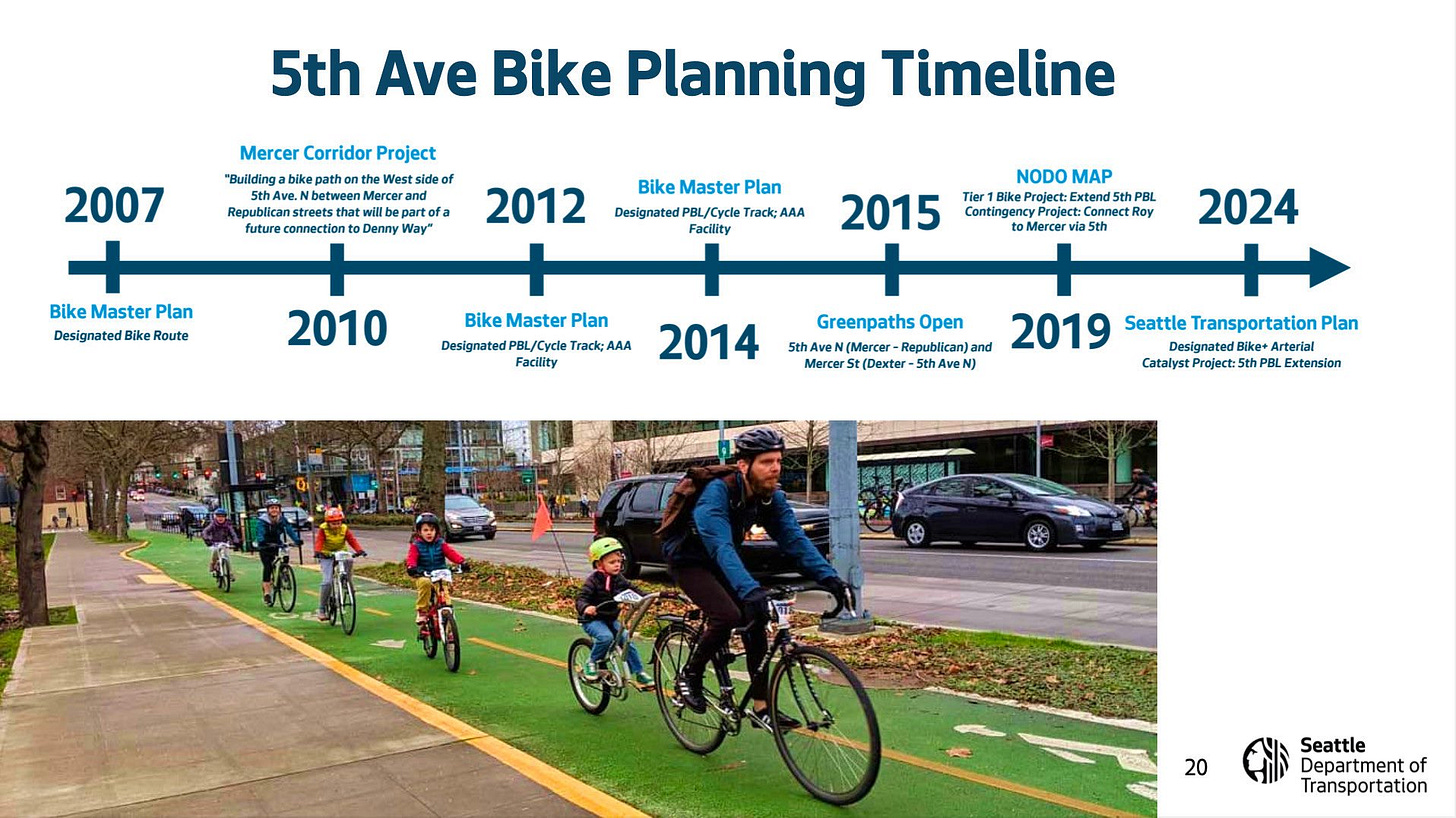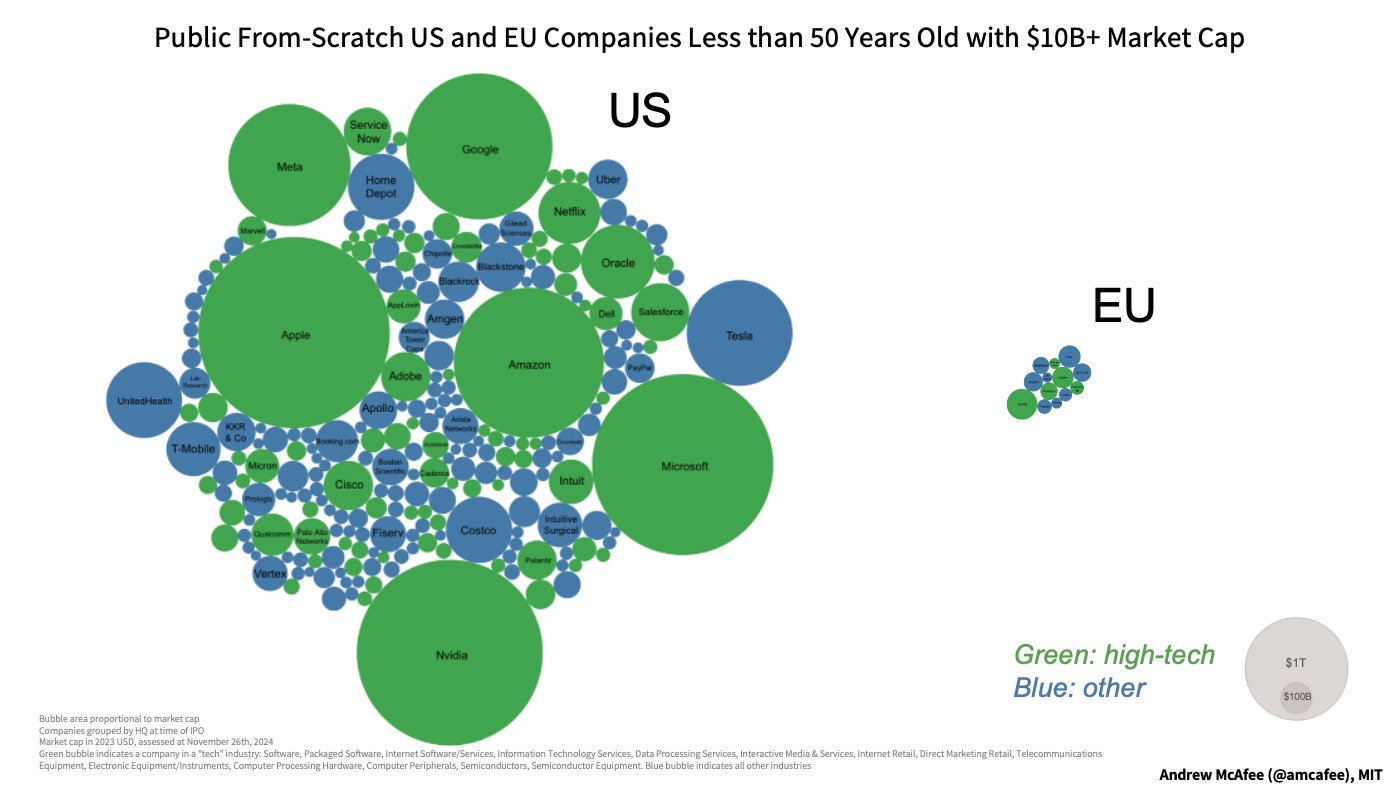Trumpdate (12.3.24):
Cooper, N-Carolina and the COVID report
EXECUTIVE SUMMARY:
NEWS NEWS
Political Showdown: North Carolina Senate overrides governor's veto, setting stage for potential lawsuit.
NOT NEWS NEWS
Financial Myth Debunked: Contrary to popular belief, most Americans can cover a $400 emergency expense with cash.
COVID Investigation: House committee concludes report suggesting lab leak origin and criticizing pandemic response policies.
Manufacturing Resurgence: US manufacturing sector adds 113,000 jobs from 2019 to 2023, linked to recent legislative policies.
Infrastructure Speed: Rapid post-disaster infrastructure repair demonstrates potential for quick national building processes.
Housing Comparison: Comparative graph suggests Americans fare well in housing compared to other countries.
Business Landscape: Stark difference in young, large publicly traded companies between US and EU.
War Expenditure: Russia dramatically increases military budget, allocating over $145 billion for 2025 defense spending.
1.) North Carolina Politics: The State Senate has overridden Gov Cooper's (D) veto of SB382 by party-line vote of 30-19. Bill goes next to House for final approval. A lawsuit expected to follow
[TS] This is quite the power grab from North Carolina Republicans:
QUICK BITES:
[TS] As predicted, Trump uses Biden’s Hunter pardon as further justification to pardon Jan 6th criminals:
[TS] Again, he would have done this regardless of Biden’s actions, but what a gift!
CNN: Trump's incoming White House press secretary purged tweets praising Mike Pence for certifying the election results and praising Capitol police. Just a year later she ran for Congress denying the 2020 election results.
2.) No it’s not true that 60% of people don’t have $400 in emergency spending.
[TS] A widely believed statement of fact that is, in fact, false. Similar to the false statement: “Most Americans are living ‘paycheck to paycheck.’”— which I’ve covered before (#4).
I’ve listed the data from the Chase Institute before, but this time the data comes right from the Federal Reserve. In short:
60% of people would finance an emergency expense with cash, not 60% can’t. From the text itself:
Sixty-three percent of adults said they would cover a hypothetical $400 emergency expense exclusively using cash or its equivalent, unchanged from 2022 but down from a high of 68 percent in 2021.
3.) The House COVID Select Concludes 2-Year Investigation, Issues 500+ Page Final Report on Lessons Learned and the Path Forward
Full report HERE. Summary HERE.
[TS] Honestly, a lot of it reads like a partisan hack job. This should have been written by sober, serious people (the topic certainly deserved it). Regardless, a few takeaways (I suppose take ‘em with a grain of salt):
COVID-19 most likely emerged from a laboratory in Wuhan, China
Wuhan is home to China’s foremost SARS research lab, which has a history of conducting gain-of-function research at inadequate biosafety levels.
Most guidelines/recommendations were bad or not based in science:
Social distancing was arbitrary
Masks did not work effectively to contain spread
Lockdowns, especially prolonged lockdowns on schools had lasting harm
Policies ignored natural immunity, pushing mandates that eroded trust and harmed public perception of science.
Incredible amounts of fraud within COVID relief programs
PAYCHECK PROTECTION PROGRAM: The Paycheck Protection Program — which offered essential relief to Americans in the form of loans that could be forgiven if the funds were used to offset pandemic-era hardships — was rife with fraudulent claims resulting in at least $64 billion of taxpayers’ dollars lost to fraudsters and criminals.
FRADULENT UNEMPLOYMENT CLAIMS: Fraudsters cost the American taxpayer more than $191 billion dollars by taking advantage of the federal government’s unemployment system and exploiting individuals’ personally identifiable information.
SMALL BUSINESS ADMINISTRATION (SBA) FAILURES: $200 million of taxpayers’ dollars were lost as a result of the SBA’s inability to conduct proper oversight, implement internal controls, and ensure fraud protection measures were enacted.
4.) Manufacturing jobs are growing in the US again
From 2019 to 2023, the manufacturing sector added 113,000 jobs.
[TS] This is directly related to Biden’s policies. Trump will, of course, take credit - but let’s hope he doesn’t suspend or end the policies. Take, for example, the CHIPS act and IRA — look at what they’re doing for US manufacturing and construction spending (graph per Joey Politano):
[TS] This type of spending curve is astonishing. Expect to see Trump's name on every IIJA, CHIPS, and IRA ribbon cut. Biden could have done it but key Dem factions thought NEPA red tape was more important than permitting reform to finish projects in <4 yrs.
Speaking of permitting and regulations…
5.) America can still build fast!
….but only after disasters.
[TS] Good article in The New Atlantis by Aiden Mackenzie about building/permitting reform. An excerpt:
In June 2023, a bridge on I-95 in Northeast Philadelphia collapsed after a tanker truck caught fire in an underpass, halting traffic along the entire corridor. But, astonishingly, the highway was reopened to traffic only twelve days later, months ahead of most predictions. The success is a showcase for a process stripped down to the basics. Pennsylvania Governor Josh Shapiro used his disaster authority, suspending any law or regulation that would impede swift recovery. Construction crews, working around the clock, engineered and built a temporary road in less than a week.
[TS] Examples in the opposite direction are endless. Take the California high speed rail project, per LA Times:
$100 billion over budget
Told voters it would be finished by 2020
Now they won’t even set a date for completion
[TS] It’s not just big projects like this, but even small ones. Look at a bike lane in Seattle. 17 years (and counting!) to study building a bike lane:
6.) US Housing vs other Countries
[TS] Based on this, Americans have it pretty good…
I do wonder if rural areas bring the average down in the US.
Speaking of US vs…
7.) US vs EU: Young Market Leaders
The bubbles on the left are US publicly traded companies that are less than 50 years old with a market capitalization of $10B+. The bubbles on the right are the same but for the EU. Graph per Andrew McAfee:
[TS] What a difference.
8.) Russia is spending record amounts on the Ukraine war.
From the AP:
Russian President Vladimir Putin approved budget plans, raising 2025 military spending to record levels as Moscow seeks to prevail in the war in Ukraine. Around 32.5% of the budget posted on a government website Sunday has been allocated for national defense, amounting to over $145 billion.
Graph per Kevin Drum:














